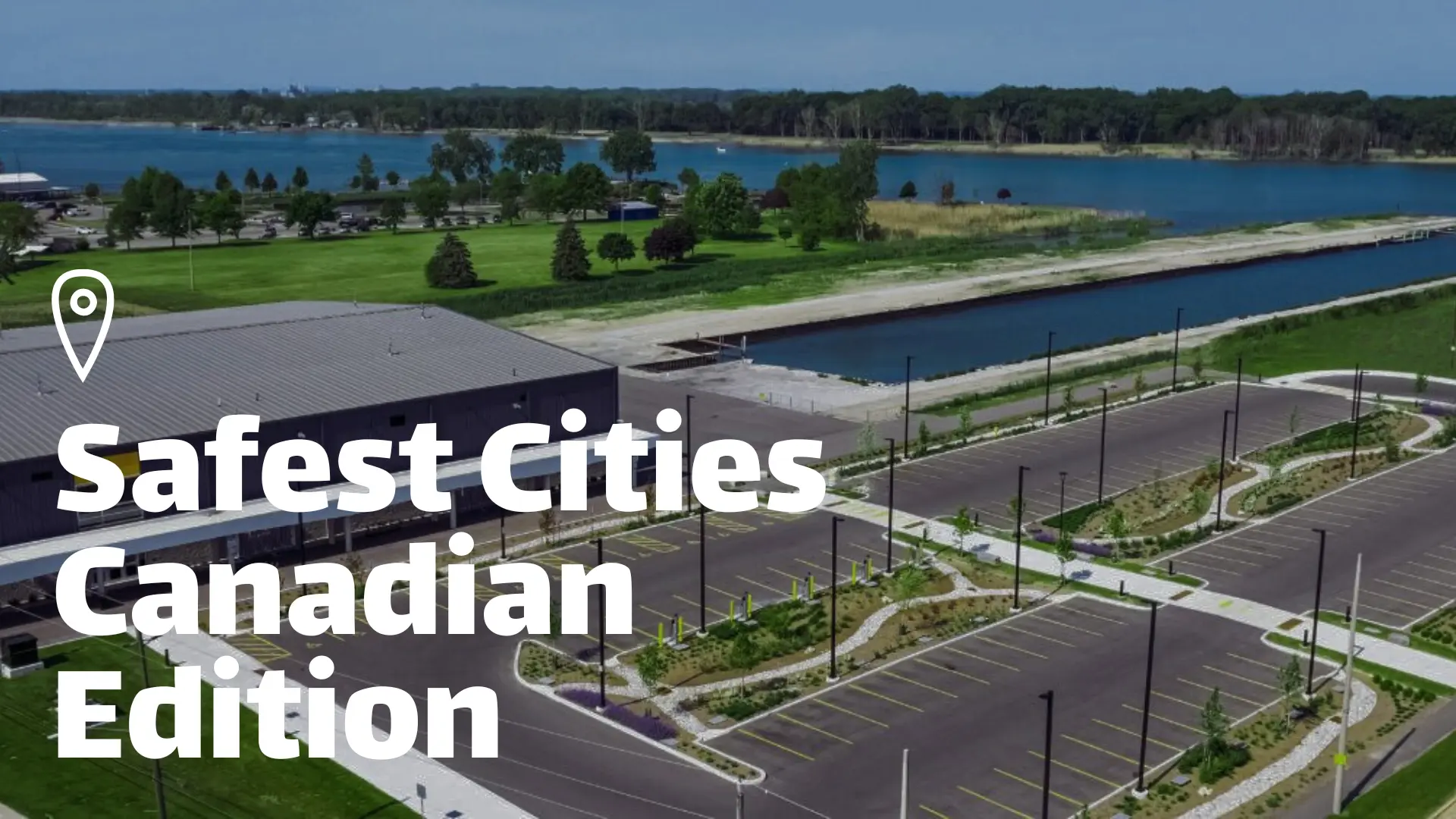Canada is renowned for its high quality of life, stunning natural beauty, and welcoming communities. One of the country’s most appealing aspects is its reputation for safety. In this article, we’ll explore the top 10 safest cities in Canada, providing valuable insights for those considering a move, planning a visit, or simply curious about the Great White North’s most secure urban centers.
Understanding Safety in Canadian Cities
Before diving into our list, it’s important to note that safety is measured using various factors, including crime rates, police-reported incidents, and community well-being indices. The cities on this list consistently rank high across multiple safety metrics, making them stand out as some of the most secure places to live in Canada for personal safety and for businesses.
According to Statistics Canada, the national Crime Severity Index (CSI) in 2023 was 75.3. All cities on this list have CSI scores significantly lower than the national average, with some boasting rates as low as 30% of the national figure.
1. LaSalle, Ontario
Nestled in the heart of Essex County, LaSalle tops our list of the safest cities in Canada. This charming town of approximately 30,000 residents boasts exceptionally low crime rates and a strong sense of community.
Key Safety Features:
- Low violent crime rate (70% below national average)
- Active neighborhood watch programs
- Well-funded police force
LaSalle’s commitment to safety is evident in its proactive community policing strategies and emphasis on youth engagement programs. Local resident Maria Thompson shares, “I’ve lived in LaSalle for 20 years, and I’ve always felt safe letting my kids play outside. The community really looks out for each other here.”
Local Attraction: Visit the picturesque LaSalle Strawberry Festival, a summer event that brings the community together in a safe, family-friendly environment.
2. Burlington, Ontario
Located on the shores of Lake Ontario, Burlington consistently ranks as one of the safest cities in Canada. With a population of about 185,000, it manages to maintain a small-town feel while offering big-city amenities.
Safety Highlights:
- Low property crime rates (50% below national average)
- Excellent emergency response times
- Robust community safety initiatives
Burlington’s success in maintaining safety can be attributed to its well-planned urban development, strong economic foundation, and active citizen participation in community safety programs.
Innovation Spotlight: Burlington has implemented a smart city initiative, including AI-powered traffic management systems that have reduced accident rates by 30% since implementation.
3. Oak Bay, British Columbia
Situated on Vancouver Island, Oak Bay is a picturesque community known for its Victorian architecture and serene coastal views. It’s also one of the safest places to live in Canada.
Notable Safety Aspects:
- Minimal violent crime (80% below national average)
- Strong community policing presence
- High resident engagement in safety initiatives
Oak Bay’s small population of around 18,000 contributes to its tight-knit community feel. Local Police Chief Robert Green notes, “Our low crime rates are a testament to the strong partnership between our department and the community. We work together to keep Oak Bay safe.”
Historical Perspective: Oak Bay has maintained its position as one of Canada’s safest communities for over three decades, a feat attributed to consistent community engagement and proactive policing strategies.
4. Lévis, Quebec
Across the St. Lawrence River from Quebec City lies Lévis, a city that seamlessly blends historical charm with modern safety standards. With a population of approximately 145,000, Lévis offers a secure environment for its residents and visitors alike.
Safety Features:
- Low overall crime rate (60% below national average)
- Effective community outreach programs
- Well-maintained public spaces
Lévis’ commitment to public safety is evident in its investment in infrastructure, community programs, and a responsive police force.
Cultural Diversity: Lévis has seen an influx of immigrants in recent years, and the city’s integration programs have been credited with maintaining social harmony and safety. Local cultural festivals celebrate this diversity while fostering a sense of community.
5. Halton Hills, Ontario
Part of the Greater Toronto Area, Halton Hills is a testament to how suburban communities can maintain high safety standards despite proximity to major urban centers. Home to about 60,000 residents, this town consistently ranks among Canada’s safest.
Key Safety Indicators:
- Low violent and property crime rates (55% below national average)
- Strong focus on youth programs
- Effective traffic safety measures
Halton Hills’ success in maintaining safety is largely due to its proactive approach to community policing and resident involvement in local safety initiatives.
Day in the Life: Sarah, a local mother of two, describes her typical day: “I start with a morning jog in one of our safe, well-lit parks. Then, I walk my kids to school without a worry. In the evening, we often attend community events where we know most of our neighbors. It’s a safe, connected life here.”
6. Rothesay, New Brunswick
Representing Atlantic Canada on our list, Rothesay is a small town of roughly 12,000 residents that offers a safe haven for those seeking a quieter lifestyle. Its low crime rates and strong community bonds contribute to its reputation as one of the safest cities in Canada.
Safety Highlights:
- Minimal reported criminal activity (75% below national average)
- Active community watch programs
- Strong emphasis on senior safety
Rothesay’s small-town atmosphere and engaged citizenry play crucial roles in maintaining its status as a safe and desirable place to live.
Emergency Preparedness: Rothesay has implemented a comprehensive emergency response plan, including regular drills and a town-wide alert system, ensuring resident safety even in unforeseen circumstances.
7. Central Saanich, British Columbia
Located on the Saanich Peninsula of Vancouver Island, Central Saanich is a district municipality that combines rural charm with urban convenience. With a population of about 17,000, it consistently ranks as one of Canada’s safest communities.
Notable Safety Aspects:
- Low crime rates across all categories (65% below national average)
- Robust emergency preparedness programs
- Strong focus on road safety
Central Saanich’s commitment to safety is reflected in its comprehensive community safety plan and active citizen participation in local initiatives.
Outdoor Safety: With its abundant natural beauty, Central Saanich has implemented innovative programs to ensure safety in its parks and beaches, including volunteer park stewards and a marine safety patrol.
8. Blainville, Quebec
North of Montreal, Blainville stands out as one of Quebec’s safest cities. With a population of approximately 60,000, this suburban community offers a secure environment for families and individuals alike.
Safety Features:
- Low violent crime rates (55% below national average)
- Effective community policing strategies
- Well-designed urban planning for safety
Blainville’s approach to safety includes a focus on preventive measures and strong collaboration between law enforcement and community organizations.
Technology in Action: Blainville has implemented a city-wide smart lighting system that adjusts brightness based on pedestrian and vehicle traffic, improving both energy efficiency and public safety.
9. North Saanich, British Columbia
Another gem from Vancouver Island, North Saanich is a district municipality known for its natural beauty and safe living environment. Home to about 12,000 residents, it consistently ranks among Canada’s safest communities.
Key Safety Indicators:
- Minimal reported criminal activity (70% below national average)
- Strong emergency response capabilities
- Active community involvement in safety programs
North Saanich’s small population and strong sense of community contribute significantly to its high safety rankings.
Community Initiative Spotlight: North Saanich’s annual “Safe and Sound” festival brings together residents, local businesses, and emergency services for a day of safety demonstrations, workshops, and community bonding.
10. Milton, Ontario
Rounding out our list is Milton, a rapidly growing town in the Greater Toronto Area. Despite its quick expansion, Milton has managed to maintain its status as one of the safest cities in Canada, with a population of approximately 110,000.
Safety Highlights:
- Low crime rates despite rapid growth (45% below national average)
- Innovative community safety programs
- Effective integration of new residents into community safety initiatives
Milton’s success in maintaining safety while experiencing significant growth is a testament to its well-planned development and strong community engagement.
Expert Insight: Urban planner Maddy Chang notes, “Milton’s approach to managing rapid growth while maintaining safety is a model for other expanding communities. Their focus on creating inclusive spaces and fostering community connections has been key to their success.”
The Absence of Major Cities
As you may have noticed, our list of the top 10 safest cities in Canada doesn’t include any of the country’s major metropolitan areas like Toronto, Vancouver, Montreal, or Calgary. This absence is indeed intriguing and warrants further discussion.
Why Aren’t Major Cities on the List?
- Population Density: Larger cities typically have higher population densities, which can correlate with higher crime rates. More people in a confined area can lead to more opportunities for crime and social friction.
- Income Disparity: Major cities often have greater income inequality, which can contribute to higher crime rates in certain areas.
- Anonymity: In larger cities, the sense of anonymity can sometimes lead to a decreased feeling of community responsibility, potentially increasing crime rates.
- Reporting and Perception: Larger cities may have more comprehensive crime reporting systems, leading to higher reported crime rates. Additionally, media coverage of crime in major cities can affect perception of safety.
- Complex Social Issues: Major urban centers often grapple with more complex social issues like homelessness, drug use, and gang activity on a larger scale than smaller communities.
Are Major Canadian Cities Unsafe?
It’s crucial to note that the absence of major cities from this list doesn’t mean they are unsafe. In fact, Canadian major cities are generally considered very safe by global standards.
- Toronto, Canada’s largest city, has a crime rate lower than many similarly sized North American cities.
- Vancouver consistently ranks as one of the most livable cities in the world, with safety being a contributing factor.
- Montreal is known for its safe and walkable neighborhoods, despite being a major metropolitan area.
- Calgary has been recognized for its low crime rates compared to other major Canadian and North American cities.
Context is Key
When interpreting safety rankings, context is crucial. While smaller cities and towns may have lower overall crime rates, they might lack the diverse amenities, cultural offerings, and economic opportunities of larger urban centers.
Dr. Sarah Johnson, an urban sociologist at the University of Toronto, explains: “Safety isn’t just about crime statistics. It’s about quality of life, access to services, and community engagement. Major cities often excel in these areas, contributing to overall well-being in ways that might not be captured in traditional safety metrics.”
Safe Neighborhoods in Major Cities
It’s also worth noting that within major cities, there are often numerous neighborhoods that rival or exceed the safety levels of the cities on our list. For instance:
- The Bridle Path in Toronto
- West Point Grey in Vancouver
- Westmount in Montreal
- Edgemont in Calgary
These neighborhoods often boast very low crime rates and high safety rankings.
Conclusion: Characteristics of The Safest Cities in Canada
The cities on this list share several common factors contributing to their high safety rankings:
- Strong Community Engagement: Residents actively participate in neighborhood watch programs and community initiatives.
- Effective Policing Strategies: Many of these cities employ community-oriented policing methods, fostering trust between law enforcement and residents.
- Well-Planned Urban Development: Thoughtful city planning contributes to safer environments by considering factors like lighting, traffic flow, and public space design.
- Focus on Youth Programs: Many safe cities invest heavily in programs that keep young people engaged and away from criminal activities.
- Economic Stability: These cities often have strong local economies, which can contribute to lower crime rates.
- Education and Awareness: Regular safety education and awareness campaigns help keep residents informed and proactive about personal and community safety.
- Technological Innovation: Many of these cities leverage smart city technologies to enhance public safety and emergency response.
- Cultural Integration: Successful diversity and inclusion programs contribute to social harmony and safety.
- Environmental Design: These cities often incorporate principles of Crime Prevention Through Environmental Design (CPTED) in their urban planning.
- Proactive Emergency Preparedness: Comprehensive plans and regular drills ensure these communities are ready for any situation.
While these ten cities stand out for their exceptional safety records, it’s worth noting that Canada, as a whole, is considered one of the safest countries in the world. The nation’s commitment to social welfare, high standard of living, and cultural emphasis on peacefulness contribute to its overall safety.
Whether you’re considering a move to Canada or planning a visit, these cities offer peace of mind along with their many other attractions. Remember, while these rankings provide valuable insights, personal experiences of safety can vary. It’s always advisable to research thoroughly and visit a place yourself to get a true feel for its atmosphere and security.
By prioritizing safety and community well-being, these Canadian cities set an example for urban centers worldwide, demonstrating that it’s possible to create thriving, secure environments where residents can truly feel at home. As Canada continues to grow and evolve, these cities show that safety, diversity, and progress can go hand in hand, creating communities that are not just secure, but vibrant and welcoming to all.




